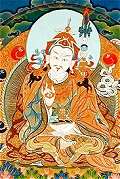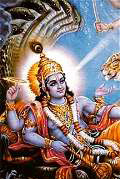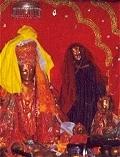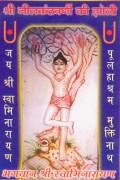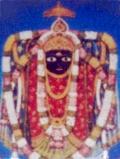 |
|||||||||||

|
Brief Introduction to Muktinath
|
||||||||||
The local name for Muktinath is Chumig Gyatsa (Hundred Waters). The tradional caretakers of Muktinath-Chumig Gyatsa are the Tibetan Buddhist Chumig Gyatsa ('Muktinath') nuns with the head of the Gye Lhaki Dung as their abbot. This family is popularly know as the Lama Domar family, an unbroken lineage of Tibetan Buddhist Nyingma lamas from Muktinath Valley, which has Chumig Gyatsa as its religious seat for centuries. The current abbot of Chumig Gyatsa is Muktinath Lama Wangyal. According toTibetan Buddhists Muktinath-Chumig Gyatsa is the home of 21 Taras, female dieties, and the residence of many Dakinis, known as Sky Dancers, energetic beings in female form, evocative of the movement of energy in space. It is of great importance for Buddhists that Chumig Gyatsa is one of the 24 Tantric places. Padmasambhava plus the Mahasiddhas blessed it with their visit. The famous Tibetan yogi Shabkar visted Muktinath in 1818 and stayed for several days to 'connect to the place', as his autobiography tells us. The Padmasambhava Statue in Narsingh Gompa can be considered the most holy object together with the Chenrezig statue. This is a very brief enumeration. More information on Buddhist backgrounds - for instance on the natural fire - can be found in the pilgrimage guide "The Clear Mirror", written down by the late abbot of Chumig Gyatsa, Muktinath Lama Jampal Rabgyé Rinpoche. See also the research published by the Muktikshetra Publication Committee, mentioned below. |
For Hindus, beside the natural fire representing Brahma and the holy waters, the central meaning of the Muktinath area is the veneration of the god Vishnu in the form of ammonites (shilas) called Salagrama-Shilas. There are many stories which tell of Vishnu turning into stone and all of them are closely connected to the holy Kali Gandaki River. This river, also known as the Salagrami, is a few hours walking from Muktinath-Chumig Gyatsa. Salagrama The building in 1815 of the Buddhist-Hindu temple of Vishnu and Chenrezig at Muktinath-Chumig Gyatsa was initiated by the Nepali Queen Subarna Prabha who considered Muktinath-Chumig Gyatsa Salagrama. The Purana legends (300-1000 AD) mention Salagrama being the most holy spot connected to the Gandaki River. Salagrama is one of The 108 Temples & Celestial Abodes of Vishnu referred by the Tamil hymns of the Alwars of the 1st millennium CE. Although the veneration of Vishnu is central nowadays, there is also a connection with Krishna as well as with Shiva. (
Salagrama, Muktikshetra and Muktinath It is difficult to understand the exact status of Muktinath-Chumig Gyatsa within Hinduism. There is no difference of opinion within Hindu schools regarding the status of the Gandaki River. However, some Hindu schools doubt that the very spot Muktinath-Chumig Gyatsa*is the Celestial Abode of Vishnu connected to the Gandaki River (Salagrama). They have the opinion that the source of the Gandaki or a cave near to it is Salagrama and the real place ('nath') of salvation ('mukti'). One of the reasons for their opinion is that contradictory to other Hindu pilgrimages sites connected to a holy river, one has to walk away from the holy Gandaki River for several hours to reach the site. Another reason is that 'Muktinath' as such is not mentioned in Hindu scriptures like the Mahabharata and the Puranas. The name 'Muktikshetra' does appear in the Varahapurana (c.144:v.122), but as the area near the Gandaki River and not as a spot in the mountains.** Also there is more than one 'Muktinath'. For instance, while Muktinath-Chumig Gyatsa is at 12,000 feet near Thorong La Pass, R.S. Gherwal locates Muktinath in his pilgrimage book - published in 1927 - at 17,000 feet near Nora Pass (p.82). Muktinath Lama Wangyal pointed out the bottom line though, when he was asked what his opinion is in the very matter: "Look at the many, many Hindu pilgrims visiting Muktinath-Chumig Gyatsa; no doubt this is a pilgrimage place for Hindus."
Swaminarayan One Hindu Guru connected to Muktinath is Lord Shri Swaminarayan, Satguru of Sabij Yoga, the goal of which is the realization of and service to God Supreme. At the end of the 18th century this Satguru practiced severe penance in Muktinath for two and a half months and attained the highest degree of proficiency in Nishkamvrat. In 2003 his followers funded the new wall around Muktinath and raised a small monument for him at Muktinath-Chumig Gyatsa. |
More
Information * See the
comment at IndianTemples.Com |
(![]() back to top)
back to top)
Annapurna
- Muktinath
Map - Muktinath
History -
Muktinath Lama Wangyal - Travel
Info - Nuns
- Picture
Gallery - Site
Map- MFI
Recommendations
Support
us with a donation

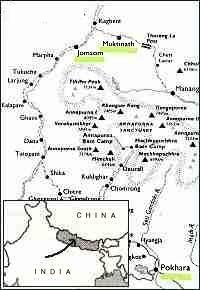 Introduction
Introduction